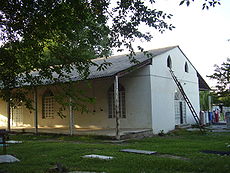
Shaykh Tabarsi
Encyclopedia

Shaykh Tabarsi
', or more correctly the Shrine of Shaykh Tabarsí, was the location of a battle between the forces of the Shah of Persia and the Bábís, followers of the Báb over the period October 10, 1848 to May 10, 1849 when the prince resorted to a plan of betrayal to capture the remaining Bábís...
, was the location of a battle between the forces of the Shah
Shah
Shāh is the title of the ruler of certain Southwest Asian and Central Asian countries, especially Persia , and derives from the Persian word shah, meaning "king".-History:...
of Persia and the Bábís, followers of the Báb
Báb
Siyyid `Alí Muḥammad Shírází was the founder of Bábism, and one of three central figures of the Bahá'í Faith. He was a merchant from Shíráz, Persia, who at the age of twenty-four claimed to be the promised Qá'im . After his declaration he took the title of Báb meaning "Gate"...
over the period October 10, 1848 to May 10, 1849 when the prince resorted to a plan of betrayal to capture the remaining Bábís. It is located in Mazandaran Province
Mazandaran Province
Mazandaran Province is a Caspian province in the north of Iran. Located on the southern coast of the Caspian Sea, it is bordered clockwise by the Golestan, Semnan, Tehran, Alborz, Qazvin, and Gilan provinces....
, Iran
Iran
Iran , officially the Islamic Republic of Iran , is a country in Southern and Western Asia. The name "Iran" has been in use natively since the Sassanian era and came into use internationally in 1935, before which the country was known to the Western world as Persia...
.
Leading up to the Battle
Mullá Husayn-i-Bushru'i, one of the most prominent Bábís, marched with 202 of his fellow disciples, under instructions from the Báb, from Mashhad to the Shrine of Shaykh Tabarsí with the Black StandardBlack Standard
The Black Banner or Black Standard is the historical flag flown by Muhammad in Islamic tradition, an eschatological symbol in Shi'a Islam , and a symbol used in Islamic extremism and Jihadism.-History:...
raised, fulfilling an Islamic prophecy. The mission was most likely proclamatory but possibly also to rescue another Bábí leader, Quddús
Quddús
Jináb-i-Quddús , is the title of Mullá Muḥammad ‘Alí-i-Bárfurúshi, who was the most prominent disciple of the Báb, a nineteenth century Prophet of the Bahá'í Faith. He was the eighteenth and final Letter of the Living....
, who was under house arrest in Sárí. Upon arriving at the Shrine, the Bábís, now under imminent attack from government forces, built a small fort and set up inside it.
Differing accounts exist as to why the battle started. Bahá'í sources describe the building of the fort as a matter of self defence, whilst polemics describe it as an attempt to start an uprising and build a Bábí state. In any case, the forces of the Persian government soon surrounded the fort and the battle commenced.
During the battle
Over the weeks that followed, more and more Bábís joined the fort with numbers rising to perhaps six-hundred. Most notable of the late arrivals is Quddús who joined after being released by Tabarsí Bábís on October 20.Bahá'ís
Bahá'í Faith
The Bahá'í Faith is a monotheistic religion founded by Bahá'u'lláh in 19th-century Persia, emphasizing the spiritual unity of all humankind. There are an estimated five to six million Bahá'ís around the world in more than 200 countries and territories....
see the battle, which was led by Mullá Husayn, as a heroic stand against oppressive government forces that lasted several months, although it is unclear whether the feeling at the time was the same.
After the battle
It is believed that eight of the disciples of the BábBáb
Siyyid `Alí Muḥammad Shírází was the founder of Bábism, and one of three central figures of the Bahá'í Faith. He was a merchant from Shíráz, Persia, who at the age of twenty-four claimed to be the promised Qá'im . After his declaration he took the title of Báb meaning "Gate"...
also called the Letters of the Living
Letters of the Living
The Letters of the Living was a title provided by the Báb to the first eighteen disciples of the Bábí Religion. In some understandings the Báb places himself at the head of this list...
were killed in the series of battles:
- Mullá Husayn-i-Bushru'i
- Muhammad-Hasan-i-Bushru'i
- Muhammad-Baqir-i-Bushru'i
- Mullá Mahmud-i-Khu'i
- Mullá Jalil-i-Urumi
- Mullá Ahmad-i-Ibdal-i-Maraghi'i
- Mullá Yusif-i-Ardibili
- Mullá Muhammad-'Aliy-i-Qazvini
Quddús
Quddús
Jináb-i-Quddús , is the title of Mullá Muḥammad ‘Alí-i-Bárfurúshi, who was the most prominent disciple of the Báb, a nineteenth century Prophet of the Bahá'í Faith. He was the eighteenth and final Letter of the Living....
was taken prisoner in the city of Barfurush. There the high priest rallied the townsfolk into a vicious frenzy. Quddus was then left to the hands of the mob who beat him to death on May 16, 1849. What remained of Quddus' body was gathered by a friend and buried nearby.

